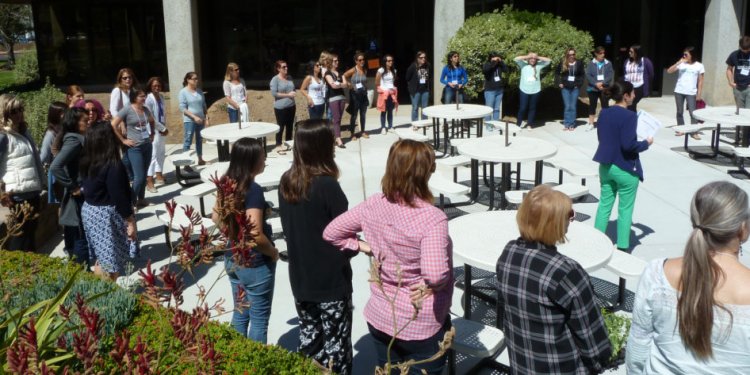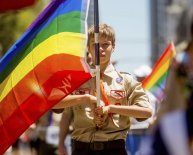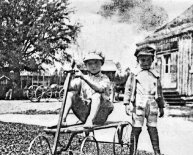
Boy Scouts California edge methods
Seabadge pin.
Upon completion of Leader Specific Training, and approval from their local council, an adult sea scout leader is eligible to attend Seabadge. As the core leadership skills training course for the BSA, Seabadge focuses on strengthening every volunteer's ability to work with groups of youth and adults and is less focused on seamanship skills.
Introduction
In 1970, a group of experienced Sea Scout officers met at the U.S. Naval Postgraduate School in Monterey, California. Their purpose was to explore the possibilities of an advanced management training experience for Sea Scout ship and administrative leaders. The result of this meeting was the Sea Scout Seabadge Conference. A curriculum was developed and the first Seabadge Conference was held a year later at the U.S. Coast Guard training facility on Governor's Island, Alameda, California. The program was repeated a few months later at the U.S. Coast Guard Station, Los Angeles, California, and then spread throughout the Northeast region and the Midwest. Recognizing the value of the program, the national committee on Sea Scouting appointed a special committee to gather the best techniques from the courses that had been conducted and consolidate them into a standard Seabadge Conference Guide. Further refinements led to this guidebook, which represents the official Seabadge Conference outline for the Boy Scouts of America. The current version was updated in 2002.
Purpose
The purposes of the Seabadge experience are:
- To provide management, leadership, and presentation skills and tools to these leaders so that they may use them and share them with others in their day-to-day activities and through leading a Seabadge conference.
- To use this understanding and these skills and tools to improve and expand both the quality and quantity of the Sea Scout program as a way to reach the Aims of Scouting.
Overview, Principles, and Approach
1. It is assumed that the participants will be well versed in the Sea Scouting program. This conference will not present any program material. To the extent that program is dealt with, except for its use as common basis for group exercises, the conference will not succeed in reaching its purposes. 2. Extensive formal training and experience in management is the prerequisite for all Seabadge instructors. A good mix of both men and women with business management backgrounds at the executive level will help. Executive managers with no background in Scouting have been found to bring refreshing views and their use is strongly encouraged. At lease one outside consultant of this type should be mandatory to a good Seabadge experience. 3. The Seabadge Conference program first presents the overall Aims and Methods of Sea Scouting and how they relate to the purposes of Scouting. It then deals briefly with instructional methods and techniques. We then get into the key issues where most of the conference time will be spent: motivational theory, management versus leadership, planning, problem solving, decision making, management principles, and finally, behavioral theory as another view before tying all this together as the basis of management and leadership. Various team exercises-each providing the opportunity to demonstrate what is gained from the previous sessions-follow, interspersed with sessions providing additional tools and techniques.The Seabadge conference is an official part of the Venturing leader training program of the Boy Scouts of America. As such, this conference guide should be followed carefully in the presentation of the conference material. Minor adjustments may be necessary because of the portion of the country involved, but care should be taken that all learning objectives are met for each conference period.
These types of recognitions are available for the Seabadge program:
1. The Seabadge certificate is to be presented to each participant upon successful completion of the conference. 2. The Seabadge recognition emblem is presented to the participants upon the successful completion of his or her Seabadge assignment. This emblem consists of a silver trident within a circle of blue olive leaves, the ancient symbol of Neptune's leadership over his dominions of the sea combined within a circle of friendship. The three prongs of the trident are symbolic of the three purposes of the Boy Scouts of America and the fact that the Seabadge participant is a spearhead of Sea Scouting in attaining the program objectives of the Boy Scouts of America. 3. There is a trident "square knot" emblem available to all Seabadge participants.Conference Format
The Seabadge conference is intended to be conducted over a weekend starting with a dinner meeting on Friday evening and concluding with a Sunday luncheon. Fifteen conference periods are involved in presenting the Seabadge material. Purposes or learning objectives have been established for each of these periods.
Course Prerequisites
Seabadge conference participants must have met the following requirements before the opening of the Seabadge conference:
1. Approval by the local Scouting Council; 2. Current registered in an adult Sea Scouting position for not less than one continuous year; 3. Completed Leader Essentials, No. 34-870, and Venturing Position Specific Training, No. 33-491C, and Sea Scout Officer Specialized Training (if available); and 4. Willing to apply the skills and knowledge obtained through the Seabadge Conference to strengthen Sea Scouting.Seabadge Underway
Seabadge Underway pin.It is the mission of Seabadge Underway (SBU) Training to provide basic vessel operation training to Sea Scout and other adult Scout leaders, with little vessel experience, to help prepare these leaders to operate a Sea Scout vessel in a safe and productive way under moderate conditions. It is also the mission of this course to provide experienced vessel operators with training in the methods and objectives of operating a Sea Scout vessel to achieve maximum benefit to the youth involved in Scouting's programs on the water

















